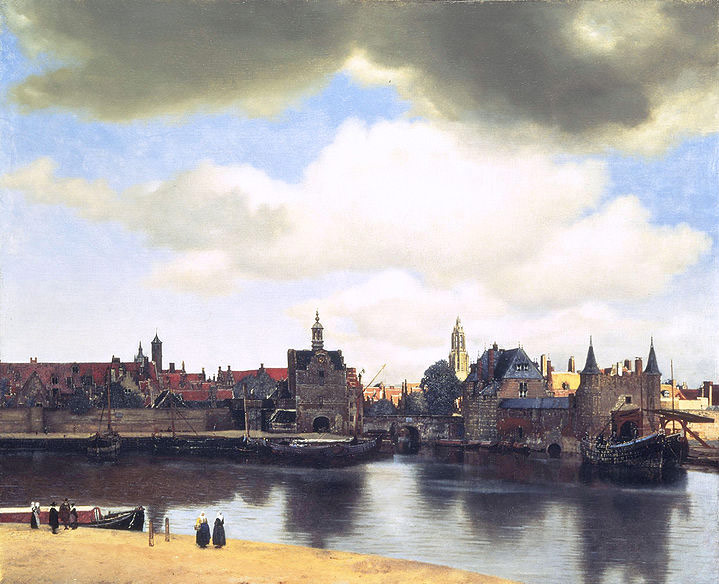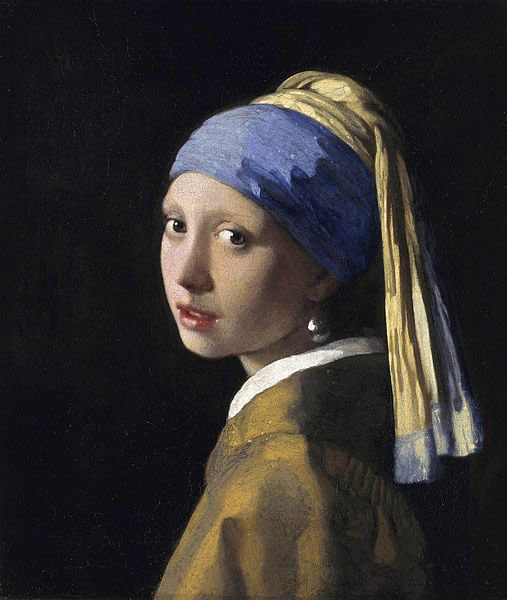| Johannes Vermeer | |
|---|---|
 |
|
| Born | Baptized Oct. 31, 1632 Delft, Dutch Republic (now Netherlands) |
| Died | Dec. 15, 1675 (at age 43) Delft, Dutch Republic (now Netherlands) |
| Nationality | Dutch |
| Education | Carel Fabritius |
| Movement | Dutch Golden Age Baroque |
| Field | Painting |
| Works | View Complete Works |
Johannes Vermeer van Delft is considered to be the most famous Dutch artists of the Golden Age, second only to Rembrandt. His life was not long, since he died at age 43 and only left around 34 paintings that have been verified as truly his own. His work continues to mesmerize the world today. He did not truly become famous until he was recognized in the 19th century by Gustav Friedrich and a fellow French art critic, and they first believed that up to 66 paintings had been created by Vermeer.
Johannes Vermeer’s life was characterized by many hardships and a rich family life. Growing up in Delft, he was largely influenced by his father, who was a middle-class worker in the silk industry. His father became an art dealer, and after his death, Johannes inherited the family art dealing business from his father when he was only 20 years old. In less than a year after leading this art dealership, he married Catharina Bolenes, who was a Catholic. He also converted to Catholicism just before their wedding, and he enjoyed financial support from his new mother-in-law.
Shortly after marriage, the couple moved into the large home of Catharina’s mother, where Johannes would continue to paint for the rest of his life. His wife gave birth to a total of 14 children altogether, and unfortunately four of those children died very young, even before being able to be baptized in the Catholic custom. It is a topic of great speculation as to who Johannes actually studied painting with. Many believe he may have been self-taught entirely. There are some who believe another Catholic man named Abraham Bloemaert may have tutored him, but there is little evidence and records from Johannes Vermeer’s life that can justify any claims of the source of his artistic influence, which remains largely a mystery.
The Professional Life and Struggles
 What has been well documented is the entry of Johannes into an artist’s trade association called the Guild of St. Luke when he was 21 years old. During this time the plague was spreading throughout Europe and the Netherlands where he lived, and although most members of this artist’s guild would normally pay a membership fee, Johannes had apparently been exempted from this charge, probably due to the common financial hardships of the time and his talent. Around this time, he met a patron who loved and bought most of his artwork. The patron was Pieter van Ruijven, whose financial support was critical to Vermeer and his family. As Vermeer matured in his artwork, he was elected head of the St. Luke’s Guild four times, beginning at age 30. His artwork gained attention within Delft, but did not spread much beyond the city.
What has been well documented is the entry of Johannes into an artist’s trade association called the Guild of St. Luke when he was 21 years old. During this time the plague was spreading throughout Europe and the Netherlands where he lived, and although most members of this artist’s guild would normally pay a membership fee, Johannes had apparently been exempted from this charge, probably due to the common financial hardships of the time and his talent. Around this time, he met a patron who loved and bought most of his artwork. The patron was Pieter van Ruijven, whose financial support was critical to Vermeer and his family. As Vermeer matured in his artwork, he was elected head of the St. Luke’s Guild four times, beginning at age 30. His artwork gained attention within Delft, but did not spread much beyond the city.
During 1672 in the Netherlands, there was a severe economic collapse due to the French invasion and the Franco-Dutch war. Due to these events, among other things, Vermeer was forced to borrow money from sources in Amsterdam in the last year of his life. He was clearly struggling to support himself and his large family, and died from frenzy, an old medical term no longer used today which included symptoms such as high fever and sometimes hallucinations. His wife suggested it had been caused by the tremendous financial pressures, and she was able to use his artwork to help the family pay off some of its debts and was able to appeal to the courts for other debts to be forgiven.
Famous Artworks
- The Girl With The Pearl Earring
- The Milkmaid
- Allegory of Faith
- The Lacemaker
- The Love Letter
- Woman Holding a Balance
- The Girl With the Wineglass
- The Astronomer
- The Music Lesson (a.k.a. Lady at the Virginals With a Gentleman)
- View of Delft
The Painting Style
The most common subjects of Vermeer’s work were usually middle-class women, and they were exceptionally detailed portraits as well as candid scenes depicted with a high degree of realism. He stood apart from other artists by his use of light in the paintings to highlight his subjects in deeply expressive ways. His style was extraordinarily lifelike, portraying intimate scenes of women indoors. He used very rich colors in ways to create deep impact for the viewers, and he would further add tiny white spots in certain places to create a feeling of more texture and sparkle where it was needed.
 Originally the artwork of Johannes Vermeer featured historical topics, both Biblical and mythological. After these much larger oil paintings, he shifted to commissioned artworks like cityscapes, using a combination of light and shadow with a partially cloudy sky to bring out depth. His greatest focus was on women performing their habitual daily activities, although his most famous work, the Girl With The Pearl Earring, is uniquely set against a solid black background.
Originally the artwork of Johannes Vermeer featured historical topics, both Biblical and mythological. After these much larger oil paintings, he shifted to commissioned artworks like cityscapes, using a combination of light and shadow with a partially cloudy sky to bring out depth. His greatest focus was on women performing their habitual daily activities, although his most famous work, the Girl With The Pearl Earring, is uniquely set against a solid black background.
Painting Techniques
It has been said that Vermeer used a typical technique of the time period referred to an underpainting, where the entire scene is painted in grays and earth tones only first and left to dry before adding color on the next layer. Underpainting, while time-consuming, added volume and an almost three-dimensional depth to paintings, distributing light and dark tones to portray illumination in the final painting. It is also evident that Vermeer often worked on only small sections of a painting at a time, with only one or two pigments at a time. His choices of paint brushes varied from stiff bristle brushes to badger brushes. Vermeer had to hand-grind the paints he would use daily, like other painters of his time. The luminosity that comes across so strongly in Vermeer’s artwork is also due to a final layer of glazing, or painting a transparent layer of paint across the final painting. Glazing techniques were also used to create certain vibrant colors when one color was painted over another, resulting in deep purples and varieties of orange, for instance.